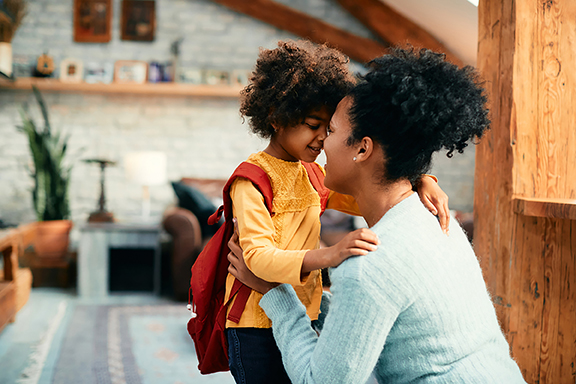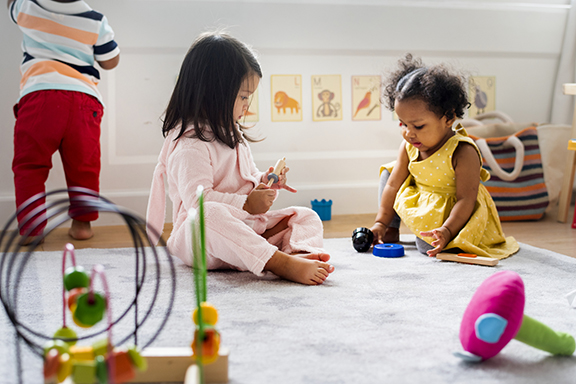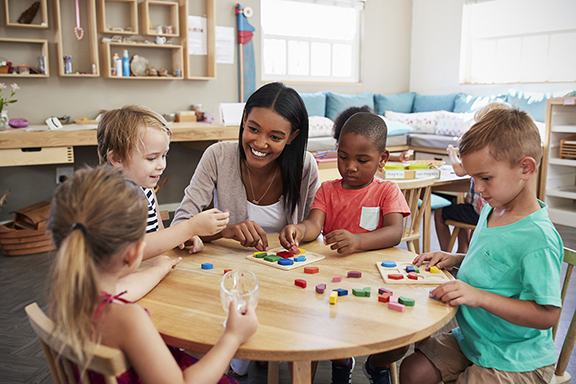Managing Stress: What Schools Can Do to Support Students in the New Normal

Kelly Fradin Pediatrician and Author
For me and almost every other parent, March 2020 was traumatic. As a pediatrician focused on school health, I began worrying well before the lockdowns hit. But as a parent, the scale of the trauma didn’t hit me until our first “two weeks to bend the curve” was extended. How was I supposed to watch my 2-year-old, facilitate the education of my 6-year-old, and work from home? If I was struggling despite all the resources we had available—reliable internet access, a well-stocked pantry, and a stable home—how would this experience rock families without those things guaranteed? And how was all of this going to affect our children?
Families faced uncertainty, fear, grief, and isolation for a long duration. At the same time, the individual experience of pandemic life was different for everyone. In the medical literature, “allostasis” refers to the physiologic balance between stress and resources to meet increased demands. When allostatic load is high and individuals face repeated or chronic stress, the “wear and tear” on the body accumulates to cause harm. As we try to understand what children have gone through, it’s important to remember although our experiences during the pandemic felt universal, even if you and I both face the same “load” of stress, the impact may be different. Extroverted children and only children may have suffered more from the isolation. Kids prone to anxiety or sleeping difficulties may have experienced higher levels of stress. Those facing poverty, food or housing insecurity, or loss of a loved one may have experienced yet another type of stress.
It’s also helpful to understand where kids’ mental health was before the pandemic. The CDC estimated that between 13 and 20 percent of children, up to nearly one in five, carried a mental health problem sufficient to justify formal diagnosis. Yet, according to the American Academy of Pediatrics (AAP), only 20 percent of these children had a provider helping meet their needs. There are numerous barriers preventing these 80 percent of children with mental health struggles, nearly 8 percent of all children, from receiving help. In short, children faced a mental health crisis before Covid-19 began to spread.
Now that vaccination has allowed our communities to come together again, we have a responsibility to do everything we can to help our children recover from the trauma of the pandemic. The importance of this cannot be overstated.
What can be done on a school level? It may seem overwhelming to respond to what has inherently been such a stressful and individual experience. Let’s consider some potential ways for how school communities can help address this problem. Many of these interventions are evidence-based, cost-effective ways to make a difference.
Share stress-relief exercises
Social and emotional curriculums promoting wellness have become standard in schools. As a pediatrician and a mom, I have seen the benefit even the youngest learners experience when they are shown yoga poses and breathing exercises and are invited to “calm down corners.” This work of filling children’s toolboxes with stress management skills makes a difference now and has the potential to make a difference across children’s lifespans.
Awareness of the links between mental and physical health difficulties has been driven by research regarding Adverse Childhood Experiences (ACEs). The seminal research in this field investigated the long-term effect of childhood traumas, such as witnessing or experiencing abuse or growing up in a household with individuals affected by substance use problems or extreme instability. The startling results have helped us understand the very concrete implications of childhood trauma later in life—increased risk of accidents, mental health problems, adverse pregnancy outcomes, sexually transmitted diseases, cancer, diabetes, risk-taking behaviors, and decreased educational outcomes.
Use the lens of trauma
Whether or not we consider the Covid-19 pandemic to be an adverse childhood experience, we can approach this year through the lens of trauma. We can use the model of trauma-informed schools to help inform our reaction, to help our students and our communities. Under this model, adults in the community are trained to recognize and respond to children who have experienced traumatic stress. Children are universally provided with coping strategies and communication strategies to guide them through stressful situations. By adopting a trauma-informed school policy, schools are prepared to respond to difficult situations before they arise—whether extreme weather or a pandemic—and it fosters an underlying culture of respect and support.
In practice, this means when a child is struggling, acting out, absent frequently, or experiencing school failure, the child, and their behaviors, are approached with curiosity rather than viewed through the lens of punitive discipline. We look to the root cause of a child’s struggle to inform the solution. While this means more work up front and more referrals for mental health counseling, hopefully this leads to more holistic, long-lasting, and effective interventions.
Bring in providers
Another promising initiative is school-based health services. The school-based health center (SBHC) approach is backed by research and has been gaining national momentum. Schools have brought dentists, primary care services, and mental health providers into adjacent health centers to improve student access to care. By bringing the providers into the school in a way that respects student choice and privacy, we increase children’s access to mental health services, decrease absenteeism, and reduce the disparities in access to services due to poverty or race. SBHCs change the environment to promote care but may not always be feasible, particularly for small independent schools.
Support kids’ sleep
Sleep is likely the most powerful drug to promote mental health functioning in our students. We know that sleep deprived individuals—many children and adults—have worse functioning. Poor sleep reduces focus and increases feelings of anxiety and depression. If school can make a change to promote healthy sleep amongst students, by staying aware of the impact of excessive homework or considering later start times, this could have a powerful impact on student’s mental health.
When we think outside of the box, another intervention has been brewing for years: school start times. There is a broad body of research suggesting that early school start times are contrary to natural adolescent circadian rhythms. Prior to the pandemic, the AAP and the American Academy of Sleep medicine had advocated for later school start times to promote adolescent sleep.
Resilience
Up to this point, I’ve discussed large scale, systemwide interventions because I think recovering from the trauma of the pandemic, and promoting the mental health of our children, now is a big problem best addressed by a big solution. However, I would be remiss to forget the power of the individual. The ACEs research has also probed predictors of resilience. When children with three or four ACEs thrive, despite all they have been through, why is this?
One of the strongest predictors of children’s success following a trauma is the presence of safe, stable, nurturing relationships and environments. We know that children who grow up with adults making them feel safe and supported are less likely to report mental distress or poor health. The AAP and the CDC have partnered for a social media campaign encouraging children to #findyour3. Schools—with their teachers, administrators, coaches, and the community of families rallied around schools—are the ideal places for children to regularly interact with these key supports.
Unfortunately, the events of the pandemic have threatened the stability and safety of the school environment. The good news is that getting back to consistent routines, activities, rules, and schedules at school—all of which were a challenge in the past two years—will promote children’s sense of safety. As case numbers come down and children are increasingly vaccinated, finding and prioritizing ways to re-engage our communities and build relationships in the safest way possible will help maximize our schools’ positive impact on students.
Works Cited
Adolescent Sleep Working Group, Committee on Adolescence, Council on School Health. “School Start Times for Adolescents.” Pediatrics, vol. 134, no. 3, 1 Sept. 2014, pp. 642–649, https://pediatrics.aappublications.org/content/134/3/642.
Crouch, Elizabeth, et al. “Safe, Stable, and Nurtured: Protective Factors against Poor Physical and Mental Health Outcomes Following Exposure to Adverse Childhood Experiences (ACEs).” Journal of Child & Adolescent Trauma, vol. 12, 15 June 2019, pp. 165–173, https://doi.org/10.1007/s40653-018-0217-9.
Larson, Satu, et al. “Chronic Childhood Trauma, Mental Health, Academic Achievement, and School-Based Health Center Mental Health Services.” Journal of School Health, vol. 87, no. 9, Sept. 2017, pp. 675–686., https://doi.org/10.1111/josh.12541.
“Mental Health Initiatives.” American Academy of Pediatrics, https://www.aap.org/en/patient-care/mental-health-initiatives/.
“What is a Trauma-Informed School?” Treatment and Services Adaptation Center, https://traumaawareschools.org/traumaInSchools.
“What is Children’s Mental Health.” Centers for Disease Control and Prevention, https://www.cdc.gov/childrensmentalhealth/basics.html.
Kelly Fradin, MD, is a pediatrician and child advocate in New York City. She is the author of Parenting in a Pandemic: How to Help Your Family through Covid-19.
This article first appeared in the 2022 issue of the Parents League Review. Get the current issue of the Review free with a family membership. Or purchase it separately.








